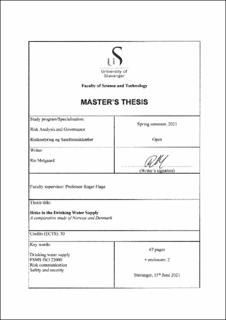| dc.description.abstract | The Norwegian and Danish consumers trust that the drinking water they receive is safe and free of contaminations. Although the drinking water is locally sourced and is treated with simple purifications steps, the two countries face risk challenges related to drinking water safety.
The characteristics of the applied risk framework and methods for safety and security in the drinking water supply in Norway and Denmark are examined and compared. Risk communication in relation to potential drinking water contaminations was also studied as previous water supply contaminations have shown that risk communication plays a crucial element in maintaining trust in the water supply companies and the municipalities.
Through a combination of literature review and performed interviews with key persons in both countries following was found: In Norway, the water supply companies apply a Risk and Vulnerability Analysis (RVA) developed exclusively for the water supply industry to handle safety-related risks. In practice, a recommended triplet approach for security aspects was rarely used as this is time-consuming and requires special competence. Assessment of potential intended malicious acts as terror was sometimes entered as an unwanted event in the water supply RVA.
It was found that Hazard Analysis and Critical Control Points (HACCP) principles are required by legislation for midsize and large drinking water supply companies in Denmark. The HACCP principles are followed by using the DDS management system or the FSMS ISO 22000:2018 standard. A notable difference is that the water supply RVA is internally reviewed, and the FSMS ISO 22000:2018 have an external audit both to achieve certification and maintain certification. Some security aspects such as access limitation are addressed in the FSMS ISO 22000:2018 standard.
The practical aspects of risk communication differ between the countries as the Danish drinking water supply companies communicate directly to their customer. Whilst in Norway, the water supply companies notify the municipalities, which then alert the customers in the respective municipality. The theoretical knowledge of risk communication presented in the thesis suggests it is preferable not having the extra link in the risk communication chain to save time in the acute phase after an event such as a drinking water contamination. Furthermore, as often several municipalities receive drinking water from the same water supply company, it can create inconsistency regarding releasing information and the content of the message. Therefore, risk communication cooperation groups across the municipality’s borders must be encouraged. | |
